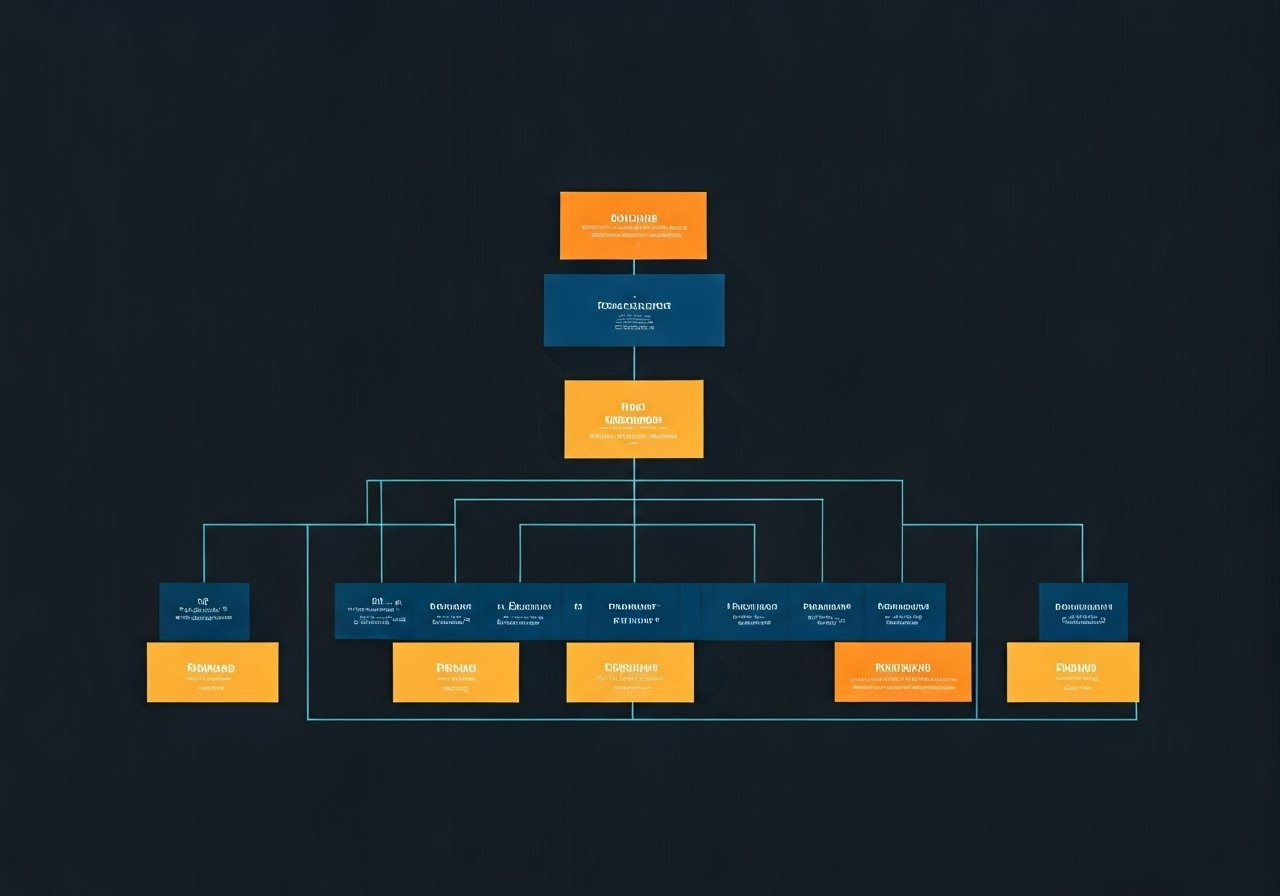Alphabet Organizational Structure in 2025
Understanding the Alphabet Org Chart: A Comprehensive Guide

Key Highlights
-
Alphabet Inc. is a new holding company started by CEO Larry Page and Sergey Brin in 2015. Google became its biggest part, as noted in a blog post by Larry Page.
-
Larry Page, the former CEO of Google, became the CEO of Alphabet. Then, Sundar Pichai became Google's CEO.
-
Alphabet uses a matrix organizational structure. This combines functional departments with product-based divisions to help drive innovation.
-
Sundar Pichai, the current CEO of Alphabet, focuses on artificial intelligence (AI) and has a unique leadership style.
-
The company manages various projects like Waymo and Verily. These are often called "Other Bets," and they make a big difference in its financial growth.
Introduction
In 2015, Alphabet Inc. was created to manage Google and its many subsidiaries. It acted as a new holding company. This change made Google a part of Alphabet. It helped Google focus on important areas like search, ads, Android, and YouTube. With Google CEO Sundar Pichai as the CEO of Alphabet, the business has grown in the tech industry. In December, it is not only working on internet services but also exploring new ideas like self-driving cars and life sciences.
Overview of Alphabet Inc.
Alphabet Inc. is the main company for Google and other branches as of September. It focuses on investing in new ideas and diversity. Larry Page and Sergey Brin, the founders of Google, started Alphabet. It has become a leading holding company with a special structure. This allows its branches, like Google Fiber, DeepMind, and Waymo, including GOOG, to work independently. This way, they can be flexible and focused in their fields.
Many compare Alphabet's structure to a matrix model. It mixes expertise with independence for different divisions. This flat and cooperative setup helps in finding new ideas in areas such as artificial intelligence, life sciences, and self-driving cars. It also allows for smart use of resources among its branches, promoting both great operations and business growth. Understanding why Alphabet was created helps us see its goals for innovation and leading in technology.
The Formation and Purpose of Alphabet Inc.
Alphabet Inc., a subsidiary of Alphabet, started in 2015 by Larry Page and Sergey Brin. It was created to help manage Google's growing operations better. This new company was a big change. It let Google focus only on its online services like search engine, ads, Android, and YouTube. Meanwhile, Alphabet took care of new projects like Waymo and Verily.
The choice to make a holding company was to ensure clear operations and accountability across different businesses, allowing for more management scale. Alphabet now manages subsidiaries with different goals. This way, each one can stay on its path while using shared resources. Larry Page, who co-founded Google, was the first CEO of Alphabet. He later passed the leadership to Sundar Pichai.
With a strong focus on new ideas and clarity, Alphabet has helped Google's subsidiaries, including Nexus, do well in competitive areas like cloud computing and AI services since April 2024. This pushes forward Alphabet's vision for the future of technology.
Google's Role Within Alphabet
Google is the largest part of Alphabet. It is responsible for creating and improving internet-related services. Google supports products like Google Search, Gmail, Google Maps, Android, YouTube, and Google Cloud. Sundar Pichai is the CEO. He has changed the unit into a leading force known for technology and products that focus on the consumer.
Google has many departments that are part of Google. These include engineering, marketing, human resources, and sales. Each department works together but does not get in the way of the others. This teamwork helps them be efficient, especially in developing new products like cloud computing platforms that enhance user interaction with search results.
Google focuses on innovation and creativity. This allows it to meet the needs of consumers effectively. Under Sundar Pichai’s strong leadership, Google keeps setting high standards in the technology industry. This helps Alphabet Inc. stay financially strong and important across the globe. Here’s how Alphabet organizes its complicated structure.
The Structure of Alphabet's Organization
 The way Alphabet Inc. is organized looks like a matrix. It combines different departments with groups based on products. This setup goes beyond old hierarchy models. It gives some subsidiaries, like Waymo and DeepMind, their own freedom while also providing support to keep things consistent.
The way Alphabet Inc. is organized looks like a matrix. It combines different departments with groups based on products. This setup goes beyond old hierarchy models. It gives some subsidiaries, like Waymo and DeepMind, their own freedom while also providing support to keep things consistent.
This method helps Alphabet gather talent and resources easily. It lets subsidiaries explore various areas like artificial intelligence and biotech. The flat structure encourages open talk and creativity, which fits the company’s goal for being a leader in technology.
Matrix Structure Explained
Alphabet uses a matrix structure that has two main parts: functional expertise and divisional focus. This allows its subsidiaries to work on new ideas while staying connected to the main company. For example, Google employees work together across common areas like engineering or marketing but also help achieve specific goals in areas like AI or life sciences.
This approach takes advantage of a large global workforce for tasks like cloud computing and the development of self-driving cars and new app technologies. It promotes teamwork and quick decision-making at all levels of management to maintain flexibility. Here’s how Alphabet Inc. works:
|
Aspect |
Examples |
|---|---|
|
Functional Departments |
Engineering, Marketing, HR, Finance |
|
Divisions/Subsidiaries |
Waymo, Google Search, DeepMind |
|
Global Collaboration |
Cloud Computing, AI, Product Development |
|
Management Approach |
Flat structure promoting employee autonomy |
This mix of working together and being independent helps Alphabet grow in technology while allowing easy communication between different departments.
Functional Departments and Product-Based Divisions
To understand how Alphabet works, we need to look at how its different departments work with product-focused divisions. These areas, such as engineering, human resources, and finance, help the main business. On the other hand, the product-based groups aim to create new ideas for fields like AI and life sciences.
-
Engineering: Works on developing products like Google Maps and Android applications.
-
Sales and Marketing: Improve brand awareness and connect with customers around the world.
-
Human Resources: Brings in and keeps the best talent to support Alphabet’s fast growth.
-
Product Development: Works on new areas like cloud computing and self-driving cars.
The connection between these departments and divisions helps Alphabet make the most of its talent and skills. This way, its subsidiaries can invent new products and stay ahead in the technology industry.
Key Leadership and Management
Leadership is a key part of Alphabet Inc. Sundar Pichai leads the company, making sure that different tech areas work well together. As the CEO of Alphabet and Google, he strengthens his impact by making important decisions and pushing for new ideas.
He is supported by a skilled management team. They have strong knowledge in areas like finance and AI. Together, this top-quality leadership at Alphabet promotes innovation, brings financial success, and supports transformative projects across all subsidiaries.
Current Leadership Team
Alphabet is led by a strong team that includes experts like Sundar Pichai, the CEO, and Ruth Porat, the Chief Financial Officer. They are important for planning and making sure that Alphabet’s parts keep up with global goals.
The board of directors, which includes Google founders Larry Page and Sergey Brin, works hard to promote clear communication and new ideas. This dedication to leadership helps growth in different areas, like Google's main internet services and Alphabet’s new projects, known as "Other Bets," like Waymo.
Also, the management structure has clear responsibilities, with heads managing different functions and project leaders handling specific tasks. This helps Alphabet create a lasting way to reach financial and technology goals.
Influence of CEO Sundar Pichai
Sundar Pichai leads with transparency, empowerment, and flexibility. As the chief executive officer (CEO) of Alphabet and Google, he has driven important changes, including investments in artificial intelligence, Google Chrome, and new research.
His focus on empowering Alphabet's subsidiaries, including those in San Francisco, has helped Waymo make progress in self-driving cars and improved AI features in Google Search. Pichai connects big goals with real actions, keeping Alphabet a leader in the technology industry despite competition.
Pichai is known for promoting clear communication. He ensures Alphabet runs smoothly while encouraging innovation. These traits reflect his leadership style and support Google's growth.
Innovative Ventures and 'Other Bets'

Under Alphabet, new and creative projects like Waymo and Verily are doing well. These are called "Other Bets," and they are working on new technologies like machine learning and life sciences. They are changing how we think about innovation at Alphabet.
Projects that deal with artificial intelligence and healthcare are key to Alphabet’s goals. They help bring solutions to the world and support financial growth. These ventures fit into the company’s aim to diversify and show their strong impact on Alphabet’s future plans.
Highlighting Waymo and Life Sciences
Waymo and Verily are great examples of Alphabet’s smart strategy. Each company helps push the limits of innovation in its own way:
-
Waymo: Leads the way in self-driving technology using machine learning.
-
Verily: Changes healthcare through life sciences research and AI tools.
-
DeepMind: Uses artificial intelligence to tackle tough global problems.
-
Google Fiber: Changes how people access the internet by providing fast connections across the United States.
These companies show Alphabet’s goal to make useful tech solutions while also entering profitable markets.
Impact of These Ventures on Alphabet’s Growth
Innovative projects at Alphabet play a big role in its financial and strategic growth. Reports from trusted sources like The Wall Street Journal and The New York Times highlight this fact. Experiments, such as Waymo's self-driving cars and Verily's healthcare analytics, strengthen Alphabet’s portfolio. This makes it clear that Alphabet is a diverse company.
Projects run by "Other Bets" bring in a lot of money and improve knowledge in AI and cloud computing. By encouraging new ideas, Alphabet spreads its tech influence across tough markets.
This ongoing strategy pushes Alphabet toward long-term growth and helps it stay a leader in technology.
Summary
Looking at how Alphabet Inc. is organized helps us understand how this large company works. They use a matrix structure, which mixes different departments with ones focused on products, similar to Google’s structure. This setup helps them work well together and be creative across their various parts. Google is the main company under Alphabet, and CEO Sundar Pichai is important in guiding the company's plan. Additionally, Alphabet's investments in new areas, like Waymo and life sciences, show its aim for growth and innovation. As we look at Alphabet's organization, we should see how these parts help the company succeed and grow in the future. If you have more questions about Alphabet or how it is set up, feel free to explore more!
Frequently Asked Questions
What is the primary function of Alphabet Inc. beyond overseeing Google?
Alphabet Inc., like Amazon, is a parent company for its subsidiaries. It focuses on being clear in its management. Established in October 2015, besides Google, it supports new ideas in areas like cloud computing, artificial intelligence (AI), and life sciences. It also allows each subsidiary to work independently to reach their specific goals.
Source Links:
https://www.reuters.com/article/us-uber-alphabet-lawsuit-idUSKBN18Q2CW
https://www.nytimes.com/2025/02/05/technology/google-diversity-goals-dei-trump.html
https://time.com/collection-post/4301266/sundar-pichai-2016-time-100/
Contact Us to request a sneak peek at the Alphabet Org Chart & Sales Intelligence Report.

